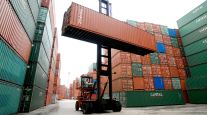Intermodal Volume Gains Accelerate in April after 8.4% Growth Over 2009 in 1st Quarter
This story appears in the May 24 print edition of Transport Topics.
Intermodal volume in the first four months of 2010 is surging ahead of 2009 levels, powered by a sharp rise in domestic container shipments and renewed growth in international freight, a trade group said.
The Intermodal Association of North America’s report on market trends, released May 14, showed growth of 8.4% in the first quarter. IANA Vice President Tom Malloy told Transport Topics that growth pace accelerated to top 9% last month.
Total intermodal traffic rose to 3.02 million revenue shipments from 2.79 million in the first quarter last year, including a 9% rise in total domestic business and 7.8% on international cargo.
“The numbers are improving, particularly for domestic containers,” Malloy said, as those shipments topped 1 million in the first quarter.
A combination of truckload, international freight that is reloaded into domestic containers at warehouses near ports and growing shipments by less-than-truckload carriers are driving the increase, he said.
First-quarter intermodal results almost matched the 3.06 million shipments in the fourth quarter, breaking from past patterns that have shown a 5% drop from the fourth quarter to the first quarter.
The sequential trends in intermodal matched the first-quarter pattern in the trucking industry. In addition, the intermodal volume growth was similar to the 8.75% rise in trucking business on a year-to-year basis, the report said.
March domestic container shipments rose 20% above the same month last year and 16% for the quarter as a whole. Intermodal trailer moves dropped 5.9%.
On the international side, volumes were “still in the doldrums” during January and February before increasing 18% in March, Malloy said.
Growing international intermodal freight is a sign of increasing optimism by retailers who are restocking consumer goods such as furniture, he added.
“Consumer spending is loosening up,” Malloy said. IANA’s report noted an 8.9% increase in first-quarter consumer spending.
Malloy also noted that the growth was the slowest in the IANA geographical region that includes Southern California, which traditionally handles the most intermodal freight. The numbers could reflect a shift of some freight to other routes, such as the Pacific Northwest, and all-water moves of freight between Asia and the U.S. East Coast through the Panama Canal, Malloy said.
Other areas, such as the Southeast and Northeast, had growth rates of 10% or more, compared with 3% in the Southwest area, the report said.
The positive direction is expected to continue.
“With the first quarter off to a quick start, it looks like intermodal is poised for a strong rebound in 2010,” the report said. “Economic recovery, continued strong service levels, growing domestic container fleets, rising fuel prices and broadening railroad product offerings all are fueling the industry’s sharp turnaround from the difficulties of 2009.”
However, the growth this year still leaves intermodal 11% below the busiest first quarter ever, which was in 2007 when 3.4 million loads were moved.
The positive trend also was tempered by concerns that economic growth, as well as new industry regulations, could impose constraints on the intermodal industry’s growth potential.
The report included analysis by FTR Associates that predicted changes such as driver hours-of-service rule revisions and the implementation of the CSA 2010 program would cut down the supply of drivers and create a shortage that could show up among drayage drivers.
That eventuality later this year could put limits on intermodal’s ability to grow, but it also could force more freight off the highways and onto intermodal routes in the 1,000-mile range, the report concluded.




